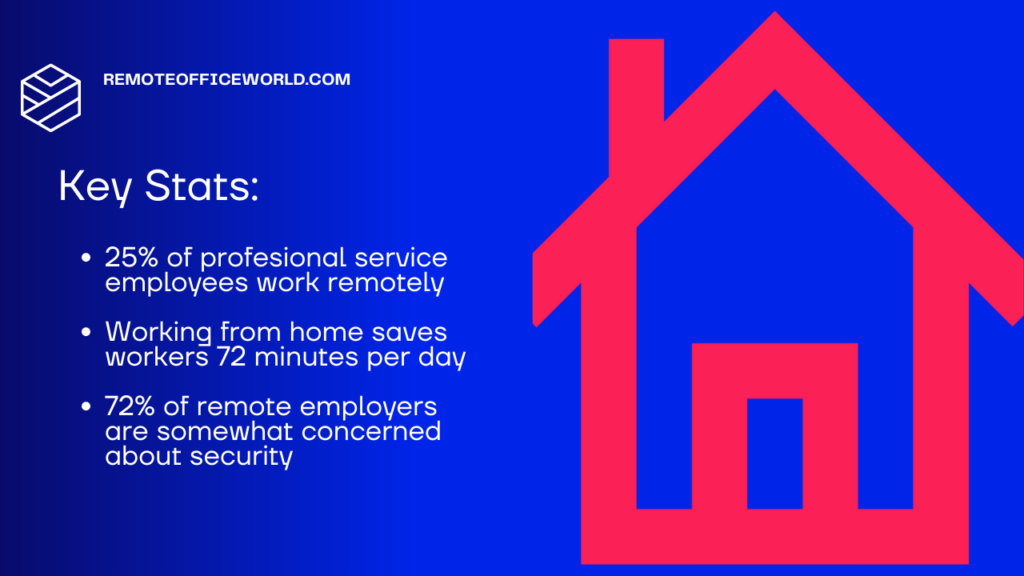Wondering if remote work is still on the rise after Covid? We’ve got you covered.
We’ve combed the far corners of the web to find every stat we could relating to remote work, past, present and future.
Choose a category that interests you or read them all. The choice is yours!
Here are our 51 remote work statistics for 2023.

Trending Remote Work Statistics
In this category you’ll find the top trending statistics for remote work to help better understand where remote employment is heading in the near future.
- 39% of knowledge workers across the globe are estimated to transition to a hybrid work model, working at least some of the time from home by the end of 2023 (Gartner).
- Tech companies are early adapters of remote work models, with 30% of remote jobs coming from the technology sector (Cord).
- By the end of 2022, more than 25% of professional service employees where working remotely according to a Canadian survey (Canadian Chamber of Commerce).
- 10.4% of people working in creative design roles are working remotely (Remote Worker).
- Remote work isn’t just for the young. 29% of workers between the ages of 55 and 65 said the opportunity to work remotely was available to them in a late 2022 study (Statista).
- While there’s been a lot of reports in the media about companies forcing people to return to work now that the pandemic’s over, the statistics seem to suggest there’s been a lot of push back from employees. According to an Owl Labs study the number of people work remotely actually increased by 24% between 2021 and 2022 (Owl Labs).
Remote Work Benefits Statistics
Remoteofficeworld.com Remote Work Statistics by Allan CalderDo remote employees feel they benefit both personally and professionally by working remotely? There are some interesting remote work statistics in this category and here are our top picks we think you’ll enjoy.
- The option to work remotely has helped to lower the number of people reporting that they are stressed at work by 4%, down from 33% to 29% (Nitro).
- The ability to work from home saves remote workers an average of 72 minutes per day according to a recent study by the National Bureau of Economic Research (NBER).
- It isn’t just extra time that remote employees are gaining by not driving to the office every day. On average, they’re saving the equivalent of $12.50 for every hour not spent commuting to and from work (Upwork).
- 62% of employees feel they are more productive when they are working remotely from a home office or backyard office instead of working out of their physical office (Owl Labs).
- In a 2023 survey, Tracking Happiness found that employee happiness increases by as much as 20% when they have the ability to work remotely (Tracking Happiness).
- 16% of global companies are fully remote and hire workers from anywhere in the world allowing there employees the freedom to chose where they want to live or travel while working (Lano).
- A staggering 87% of professionals reported that the ability to work remotely some or all of the work week has improved their work-life balance (FlexJobs).
Remote Work Statistics On The Challenges of Working Remotely
While remote work is generally viewed in a positive light, there are challenges that come with the territory. Here are some statistics that represent the potential downsides of working remotely.
- According to Buffer, 16% of remote workers reported that they struggle with collaboration. On the flip side, that means a surprising 84% of remote employees did not find it hard to collaborate with coworkers when working from home (Buffer).
- Many working from home find it challenging to maintain work and life boundaries. According to the US Conference Board, 47% of remote workers are concerned about the lack of boundaries between their work and home lives (Conference Board).
- In a 2023 UK study, 40% of remote or hybrid workers reported feeling lonely while working at home. Most respondents indicated it was the interaction with their coworkers they missed the most while working out of a home office (The Telegraph).
- 72% of remote employers reported feeling at least somewhat concerned about online security for their employees working from remote locations outside of the office (Statista).
Remote Work Statistics On Productivity and Performance
The debate continues to rage on about whether employees are more productive working in a physical office for an employer or working in a remote setting from home or on the road. Checkout these statistics on remote work productivity and performance. Some of them may surprise you.
- Read any headline recently and you’d think most employers are firmly against the switch to remote work. Surprisingly, 85% of businesses said that company productivity has increased since allowing their employees more flexible work options that includes working remotely some of the time (IWG).
- An eye popping 72% or remote workers report that they do not have a dedicated workspace while working at home. Many find themselves working at a kitchen island, a dining room table or on a laptop in a bedroom (Nulab).
- Some companies have reported a 40% increase in remote worker productivity and that this is closely related to having a dedicated workspace for focus (GoRemotely).
- 78% of full time remote workers report feeling more engaged with their work than they did when commuting daily to a physical office (Quantum Workplace).
- In a survey conducted by Statistics Canada, 32% of teleworkers reported accomplishing more work in an hour than they were able to manage when working from their corporate office (StatCan).
Remote Work Statistics Related to Corporate Culture
Corporate Culture is an essential ingredient in the success of any company, but how is it affected when employees are allowed to work remotely? Here are some statistics that take a direct look at that topic.
- 75% of remote workers feel strongly connected to their colleagues even when working in different time zones (Buffer).
- 34% of respondents to a GitLab survey said that leadership transparency from their organization improved their ability to feel connected to work and their colleagues (GitLab).
- In a recent survey, 84% of remote employees said that common workplace challenges and disagreements tended to drag on longer when working remotely from home (Harvard Business Review).
- 60% of employers require their remote employees to install remote monitoring software on their computer to track productivity (Digital.com). This is a concerning statistic as it can lead to feelings of dissatisfaction among remote workers that feel “spied” on.
Remote Work Statistics On Tools and Technology

The tools and technology a company uses can be the difference between success and failure. Checkout these remote work statistics on tools and technology.
- 43% of remote company teams use video conferencing software on a regular basis (LiveWebinar).
- Only 21% of companies use standardized project management software with remote employees (saaslist).
- 80% of remote workers use standard collaboration tools while working remotely with other team members in their organization (Gartner).
- 52% of full time American remote workers use a VPN to connect to company computers every time they logon. Another 14% say they use a VPN some of the time (YouGov).

Find more statistics at Statista
Remote Work Statistics on Future Growth
While it’s hard to accurately predict the pace of acceleration that the remote work scene will experience in the next few years, it’s clear that the trend towards working remotely is only going to increase. Here are some statistical projections for remote work in the future.
- According to Linkedin, there will be 80 million remote workers between the USA and Europe by 2030 (Linkedin).
- 84% of companies recognize the importance of a hybrid work model for employee mental health and are actively working on or considering an implementation plan (Zippia).
- FlexJobs found that 84% or respondents to a recent survey felt that companies switching to a hybrid work model would make them happier and positively affect their mental health (FlexJobs).
- The global Virtual Reality market is expected to grow from $25.1 billion in 2023 to more than $165 billion in 2030 and a big part of that growth will be through the adaptation of virtual office environments (Fortune Business Insights).
Miscellaneous Remote Work Statistics
Some remote work statistics just don’t seem to fit neatly into one category. For these ones I’ve created a miscellaneous category because they were just to good not to include here!
- At the moment, women make up only 38% of the workforce, but when it comes to remote work they constitute a staggering 58% of the workforce (GitLab)!
- 39% of employees that currently have the option to work remotely say they would quit if that option was taken away (OwlLabs).
- 52% of employees say they would be willing to accept a pay cut of 5% or more to keep working from home (OwlLabs).
- Surprisingly, remote workers actually work an average of 1.4 days more per month than employees working in a physical office (Airtasker).
- 67% of workers say that hybrid work allows them to use their time more efficiently (Gallup).
- According to 46% of remote workers, they’re able to spend more time with family because they’re working from home (FlexJobs).
- 62% of remote workers say they are considering purchasing a tiny backyard office (Business Insider).
- While the majority of workers would love to work remotely, it isn’t possible for all occupations. Only 56% of jobs can be performed remotely — at least based on current technology. That’s bound to trend upwards in the near future (Global Workplace Analytics)!

Find more statistics at Statista
- It’s estimated that as much as 86% of work in the finance and insurance industries will be done remotely in the near future (McKinsey).
- Mark Zuckerberg estimates 50% of Facebook employees will be working remotely by 2030 (NBC News).
- Remote workers can save as much as $7000 per year by eliminating their daily commute (Ever Hour).
- 20% of Google’s workforce works from home and all employees are allowed to choose 4 weeks per year when they don’t have to work from the main office (Google).
- Microsoft employees that wish to work remotely more than 50% of the time, must have the approval of their managers to increase time spent at home (WealthManagement.com).
- 36.7% of Apple employees said they were concerned they would have to leave their employment at the company because there weren’t enough remote work opportunities (The Verge).
- Amazon now allows their workers to work from home 2 days per week or 40% of their work week (AP News).
- In 2023 63.4% of Hubspot employees are choosing the remote work option that the companies liberal policies allow (HubSpot).
- Recent Spanish research found that remote work may reduces pollutants in the atmosphere by as much as 10% (Forbes)
Next Steps
Now that you’re up to speed on all of the latest remote work statistics what’s next? If you’re seriously considering starting your own remote work journey from your backyard office, check out the link below on how to get started:


